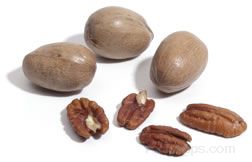Share Information | When a Fast Food Meal is Unavoidable
Don't Force Foods on Children | Offer Variety | Don't Dictate Portion Size
Get Children Involved in Meal Preparation | Shop for Healthy Snack Foods
|
Getting kids to eat a healthy diet has been the goal of most parents for generations. Many parents have found that this is easier said than done. With the media bombardment of advertisements featuring all types of improper food choices, it's no wonder that parents have trouble enforcing a healthy diet. And, with today's emphasis on "super sizing," especially of fast food meals featuring many of the most fat-laden and high calorie foods, it's also not surprising that childhood obesity has become such a problem.
Perhaps the most important single thing that any parent can do to ensure that their children are following a healthy diet is to teach by example. Children pick up on everything. Young children are especially prone to mimicking their parents, so setting a bad example is easily taught. Children don't instinctively choose to eat foods that are bad for them; they have to learn it, so parents must be aware that everything they do and everything they eat makes an impression on their kids. Teach kids that a healthful, nutritious diet is the smart thing to do. Running through the drive-up window for most of your meals is not going to emphasize this message.
Yes, peer pressure and advertising contribute to the poor food choices of today's kids, but parents are still the most influential source of information for their children. There are a number of things parents can do to ensure that they are doing their part in contributing to the proper nutrition of their children. The following suggestions for encouraging children to maintain a healthy diet may help parents to achieve this goal. |
Share Information
|
Share nutritional information with your kids. Don't assume that because they are too young they cannot learn about proper nutrition. Simply telling them that a certain food isn't good for them may only lead to confusion.
|
 "Dad, if ice cream isn't good for me, how come you eat it all the time?" "Dad, if ice cream isn't good for me, how come you eat it all the time?"
"Because I'm a grown up, and when you grow up, you can eat it as often as you want, but you really shouldn't."
"Huh?" |
Educate yourself so that you can educate your children. Learn about nutrition and how the specific components of food impact your health. Study the nutritional profiles of specific foods in order to understand which foods are high in saturated fat, which foods are the best choices for protein, which foods are high in empty calories, and so on. Reading the nutritional labels on food products is a good way to learn about the positive and negative aspects of specific foods. This will help you to teach your children about the foods that they should eat and the foods that should not become a regular part of their diets.
|
 "Johnny, that dessert isn't good for you." "Johnny, that dessert isn't good for you."
"Well, Mom, I've seen you eating it sometimes."
"Yes, but I really shouldn't. I have it as a special treat once in awhile because it tastes so good, but it isn't very healthy—it's very high in saturated fat."
"What's saturated fat?"
"Well, it's something in certain foods that causes you to gain weight and clogs your blood vessels."
"What do you mean—clogs your blood vessels?"
"Well, when you eat too many foods with high amounts of saturated fat, some of it...." |
Since children are naturally inquisitive, they can learn so much about proper nutrition if you take the time to educate yourself and engage your children in the process. |
When a Fast Food Meal is Unavoidable
|
If it's necessary to grab a fast food meal, and for most busy families that's almost a guarantee, emphasize with your kids that they should choose the healthiest items on the menu. Don't let your kids rule on this one. Once again, educating yourself on the types of foods that are best for proper nutrition will help you make the best fast food choices for your children. Ordering the side salad may sound healthy, but drowning it in dressing loaded with saturated fat makes it no better than a greasy burger.  On the other hand, the side salad with an olive oil and vinegar dressing is a good choice. The dressing is still high in fat, but not saturated fat: Olive oil contains a high percentage of heart-healthy monounsaturated fat. (Too much of the olive oil dressing, however, can contribute to weight gain, because it is still high in calories.) Your kids may not understand what you are talking about when you mention "monounsaturated," but they can understand when you tell them, "This type of salad dressing is much better for you than that salad dressing, because.... See the difference in appearance? This one is full of...." On the other hand, the side salad with an olive oil and vinegar dressing is a good choice. The dressing is still high in fat, but not saturated fat: Olive oil contains a high percentage of heart-healthy monounsaturated fat. (Too much of the olive oil dressing, however, can contribute to weight gain, because it is still high in calories.) Your kids may not understand what you are talking about when you mention "monounsaturated," but they can understand when you tell them, "This type of salad dressing is much better for you than that salad dressing, because.... See the difference in appearance? This one is full of...." |
Don't Force Foods on Children
|
When you were a kid, do remember this?
|
 "Eat all of your broccoli—it's good for you." "Eat all of your broccoli—it's good for you."
"But, I don't like broccoli."
"Well, you're not getting up from this table until you eat every bit of it!" |
It's never a good idea to force certain foods on your children, just as it's not a good idea to let your children dictate what their diets should be. Encourage children to try new foods and don't give up after one unsuccessful attempt. Several attempts are often required to entice children to try a new food, which they may discover they actually like after they have tasted the food on a number of occasions. If your child agrees to try a new food but then says, "Ick!" don't force them to finish it. If after a number of unsuccessful attempts your child still refuses to eat his or her spinach, perhaps it's time to offer another new vegetable, which may go over much better.
Time and patience are often required to get children to eat a number of new foods that are good for them but they may not think are appetizing. Children are much more likely to try new foods when they are given encouragement and positive reinforcement rather than threats and intimidation. They may even be willing to eat small amounts of a healthy food that they don't particularly like in order to please Mom and Dad who haven't forced it upon them but who have reminded them in a positive manner of how nutritious it is. |
Offer Variety
|
Encourage your children to eat the same healthy foods that you enjoy, but make sure to offer a wide variety of foods for meals and snacks. When your kids have had exposure to numerous foods, it is much easier for them to choose several foods that they like from each of the important food groups. How many times have you heard something like this?
 "You know, I'm thirty-two years old and this is the first time I've ever had asparagus, and I must say that I really like it! I didn't think I would because my parents didn't like it, so they never prepared it when I was growing up. I've never given any thought about trying it since then." "You know, I'm thirty-two years old and this is the first time I've ever had asparagus, and I must say that I really like it! I didn't think I would because my parents didn't like it, so they never prepared it when I was growing up. I've never given any thought about trying it since then." |
When parents adhere to a limited diet—Monday is roast beef night, Tuesday is casserole, and so on—their children are at an immediate disadvantage. Rarely does a child like all of the foods that his or her parents like; therefore, from the few items that are left that the child may actually like, he or she has a reduced chance for eating a healthy diet. You may not like asparagus, but your child might love it if given the chance to try it. When you expose your children to a variety of healthy foods, some of which you may not like yourself, you give them a greater opportunity to develop their own tastes and to discover a number of nutritious foods that they like; therefore, you will give them a greater opportunity to maintain a healthy diet. |
Don't Dictate Portion Size
 Allow children to dish up their own portions at mealtime. Don't pile an adult-size serving onto a child's plate and expect them to stuff it into their child-size stomach. And yes, if you allow your children to serve themselves, occasionally their eyes may be bigger than their stomachs, but don't let a few occurrences sway you from letting your kids take an active part in making diet and nutrition related decisions. Some children, however, may repeatedly take more than they can eat, so adult guidance may be necessary in these instances. Allow children to dish up their own portions at mealtime. Don't pile an adult-size serving onto a child's plate and expect them to stuff it into their child-size stomach. And yes, if you allow your children to serve themselves, occasionally their eyes may be bigger than their stomachs, but don't let a few occurrences sway you from letting your kids take an active part in making diet and nutrition related decisions. Some children, however, may repeatedly take more than they can eat, so adult guidance may be necessary in these instances. |
Get Children Involved in Meal Preparation
|
 Getting your children involved in the preparation of a family meal is often a good way to encourage them to try new foods. When children help out, they feel a sense of pride and ownership in the results, and they may be much more willing to try new foods if they've had a hand in preparing them. Something as simple as asking your child to remove peas from the pod may be all that is necessary for a kid to decide that he or she should try the dreaded vegetable, especially when they hear comments such as, "Suzie, you did a great job on the peas tonight. They're really good!" Getting your children involved in the preparation of a family meal is often a good way to encourage them to try new foods. When children help out, they feel a sense of pride and ownership in the results, and they may be much more willing to try new foods if they've had a hand in preparing them. Something as simple as asking your child to remove peas from the pod may be all that is necessary for a kid to decide that he or she should try the dreaded vegetable, especially when they hear comments such as, "Suzie, you did a great job on the peas tonight. They're really good!"
|
Shop for Healthy Snack Foods
|
Kids love between meal snacks (hey, most adults do too!). With the busy schedules of today's parents and kids, it's often impossible for parents to monitor the types of foods that their children are eating throughout the day. Pizza, chips, candy, and pop might be the daily diet of many kids if given the chance. And let's face it; kids wouldn't be kids if they didn't indulge in unhealthy between meal snacks occasionally. The operative word here is occasionally. It's not going to cause a major problem when a child is allowed to have a special treat now and then; however, in order to promote healthy eating at an early age, junk foods should be the exception, not the rule. In many cases, it may be safe to assume that children are getting their hands on junk foods while they're not under the supervision of their parents—from their friends, while walking home from school and stopping off at the corner market to soothe their candy cravings, and so on; therefore, at home, it's often best when you offer your kids the healthiest snacks that you can find. Foods that provide a variety of flavors, appealing textures, or natural sweetness, can be chosen from all of the major food groups.
Healthy Between Meal Snack Ideas

- Serve pretzels rather than greasy potato chips.
|
|

- Provide plain popcorn—no butter added—as an alternative to fat-laden commercially prepared chips.
|
|

- Try flavored rice cakes or low-fat breakfast bars rather than cookies or dessert bars.
|
|

- Offer your kids flavored yogurt, pudding packs, or applesauce instead of ice cream.
|
|

- Let your kids enjoy flavored sorbets or popsicles instead of ice cream bars.
|
|

- Serve natural fruit juices (100% juice; not the sugar-filled fruit drinks) instead of soda pop.
|
|

- While many kids may not like vegetables, most kids like some sort of fruit. Serve fruits that are handy and easy for kids to eat, such as seedless grapes, bananas, strawberries, apple wedges, or orange segments.
|
|

- Dried fruits, such as raisins, craisins, and apricots, have a chewy texture and concentrated sweet flavor that kids love.
|
|

- If your children are hesitant about eating cooked vegetables at mealtime, try serving raw veggies with a low-fat veggie dip at snack time. Raw vegetables such as carrots, broccoli flowerets, celery, or cherry tomatoes are good choices.
|
|

- Plain nuts and seeds are good snack choices for kids who like to munch while doing homework or watching television. It is important, however, to provide a limited serving, because while nuts are rich in nutrients and heart-healthy monounsaturated fat, they are also high in calories, so overindulgence can contribute to weight gain.
| |

 "Dad, if ice cream isn't good for me, how come you eat it all the time?"
"Dad, if ice cream isn't good for me, how come you eat it all the time?" "Johnny, that dessert isn't good for you."
"Johnny, that dessert isn't good for you." On the other hand, the side salad with an olive oil and vinegar dressing is a good choice. The dressing is still high in fat, but not saturated fat: Olive oil contains a high percentage of heart-healthy monounsaturated fat. (Too much of the olive oil dressing, however, can contribute to weight gain, because it is still high in calories.) Your kids may not understand what you are talking about when you mention "monounsaturated," but they can understand when you tell them, "This type of salad dressing is much better for you than that salad dressing, because.... See the difference in appearance? This one is full of...."
On the other hand, the side salad with an olive oil and vinegar dressing is a good choice. The dressing is still high in fat, but not saturated fat: Olive oil contains a high percentage of heart-healthy monounsaturated fat. (Too much of the olive oil dressing, however, can contribute to weight gain, because it is still high in calories.) Your kids may not understand what you are talking about when you mention "monounsaturated," but they can understand when you tell them, "This type of salad dressing is much better for you than that salad dressing, because.... See the difference in appearance? This one is full of...." "Eat all of your broccoli—it's good for you."
"Eat all of your broccoli—it's good for you." "You know, I'm thirty-two years old and this is the first time I've ever had asparagus, and I must say that I really like it! I didn't think I would because my parents didn't like it, so they never prepared it when I was growing up. I've never given any thought about trying it since then."
"You know, I'm thirty-two years old and this is the first time I've ever had asparagus, and I must say that I really like it! I didn't think I would because my parents didn't like it, so they never prepared it when I was growing up. I've never given any thought about trying it since then." Allow children to dish up their own portions at mealtime. Don't pile an adult-size serving onto a child's plate and expect them to stuff it into their child-size stomach. And yes, if you allow your children to serve themselves, occasionally their eyes may be bigger than their stomachs, but don't let a few occurrences sway you from letting your kids take an active part in making diet and nutrition related decisions. Some children, however, may repeatedly take more than they can eat, so adult guidance may be necessary in these instances.
Allow children to dish up their own portions at mealtime. Don't pile an adult-size serving onto a child's plate and expect them to stuff it into their child-size stomach. And yes, if you allow your children to serve themselves, occasionally their eyes may be bigger than their stomachs, but don't let a few occurrences sway you from letting your kids take an active part in making diet and nutrition related decisions. Some children, however, may repeatedly take more than they can eat, so adult guidance may be necessary in these instances. Getting your children involved in the preparation of a family meal is often a good way to encourage them to try new foods. When children help out, they feel a sense of pride and ownership in the results, and they may be much more willing to try new foods if they've had a hand in preparing them. Something as simple as asking your child to remove peas from the pod may be all that is necessary for a kid to decide that he or she should try the dreaded vegetable, especially when they hear comments such as, "Suzie, you did a great job on the peas tonight. They're really good!"
Getting your children involved in the preparation of a family meal is often a good way to encourage them to try new foods. When children help out, they feel a sense of pride and ownership in the results, and they may be much more willing to try new foods if they've had a hand in preparing them. Something as simple as asking your child to remove peas from the pod may be all that is necessary for a kid to decide that he or she should try the dreaded vegetable, especially when they hear comments such as, "Suzie, you did a great job on the peas tonight. They're really good!"








